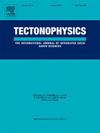Physics-based simulations of earthquake scenarios on the Kopili fault in Northeast India: Insights into seismic hazard and fault mechanics
IF 2.6
3区 地球科学
Q2 GEOCHEMISTRY & GEOPHYSICS
引用次数: 0
Abstract
Understanding the seismic risks associated with the Kopili fault (KF) in northeast India is essential for effective risk management. We employed advanced physics-based dynamic rupture simulation scenarios to quantify the fault’s potential for generating damaging earthquakes. Our models indicate that the central KF segment can produce significant earthquakes with moment magnitudes (Mw) potentially reaching 7.3, and possibly up to 7.5. The analysis revealed considerable variability in rupture extent and ground motion characteristics, strongly influenced by fault and model parameters. A detailed stress inversion analysis shows that the maximum horizontal stress () is oriented at N41°E within an oblique-reverse stress regime, significantly impacting rupture behavior. Rupture simulations indicate that earthquakes originating from the central segment of the fault produce the largest rupture areas and the most intense ground shaking, with peak ground velocities exceeding 0.6 m/s and corresponding intensities of MMI VIII and above. Sensitivity analyses highlight the critical roles of nucleation points, dynamic rupture parameters and orientation in determining rupture propagation and ground motion distribution. Notably, minor adjustments in , such as a 10° variation, can lead to substantial changes in rupture characteristics, including extreme scenarios reaching Mw 7.5 in the counterclockwise stress rotation. Additionally, supershear effects observed in several scenarios likely stem from initial stress variations along the fault. The physics-based simulation of ground motion shows that, compared to ground motion prediction equations (GMPEs) estimates, it provides more reliable predictions. These insights enhance our understanding of how these parameters influence earthquake dynamics and are vital for developing effective earthquake risk management strategies in northeast India. By integrating physics-based dynamic rupture modeling with empirical ground motion predictions, our study could provide a robust framework for seismic hazard assessment in the KF zone and similar tectonic settings.
印度东北部Kopili断层地震情景的物理模拟:对地震危险性和断层力学的见解
了解与印度东北部Kopili断层(KF)相关的地震风险对于有效的风险管理至关重要。我们采用先进的基于物理的动态破裂模拟场景来量化断层产生破坏性地震的潜力。我们的模型表明,中部KF段可能产生矩震级(Mw)可能达到7.3级,甚至可能高达7.5级的重大地震。分析显示,断裂程度和地震动特征有很大的变化,受断层和模型参数的强烈影响。详细的应力反演分析表明,最大水平应力(SH)在斜-逆应力范围内面向~ N41°E,显著影响破裂行为。破裂模拟结果表明,源自断层中央段的地震产生最大的破裂区和最强烈的地面震动,峰值地面速度超过0.6 m/s,相应的强度为MMI VIII及以上。敏感性分析强调了成核点、动态破裂参数和SH方向在确定破裂传播和地震动分布中的关键作用。值得注意的是,SH的微小调整,例如10°的变化,可以导致破裂特性的实质性变化,包括在逆时针应力旋转中达到7.5 Mw的极端情况。此外,在几种情况下观察到的超剪切效应可能源于断层沿线的初始应力变化。基于物理的地面运动模拟表明,与地面运动预测方程(GMPEs)估计相比,它提供了更可靠的预测。这些见解增强了我们对这些参数如何影响地震动力学的理解,对于在印度东北部制定有效的地震风险管理策略至关重要。通过将基于物理的动态破裂模型与经验地震动预测相结合,我们的研究可以为KF带和类似构造环境的地震危险性评估提供一个强大的框架。
本文章由计算机程序翻译,如有差异,请以英文原文为准。
求助全文
约1分钟内获得全文
求助全文
来源期刊

Tectonophysics
地学-地球化学与地球物理
CiteScore
4.90
自引率
6.90%
发文量
300
审稿时长
6 months
期刊介绍:
The prime focus of Tectonophysics will be high-impact original research and reviews in the fields of kinematics, structure, composition, and dynamics of the solid arth at all scales. Tectonophysics particularly encourages submission of papers based on the integration of a multitude of geophysical, geological, geochemical, geodynamic, and geotectonic methods
 求助内容:
求助内容: 应助结果提醒方式:
应助结果提醒方式:


